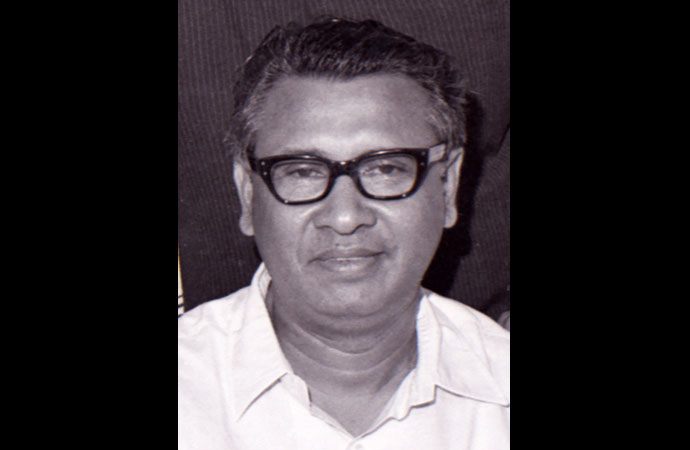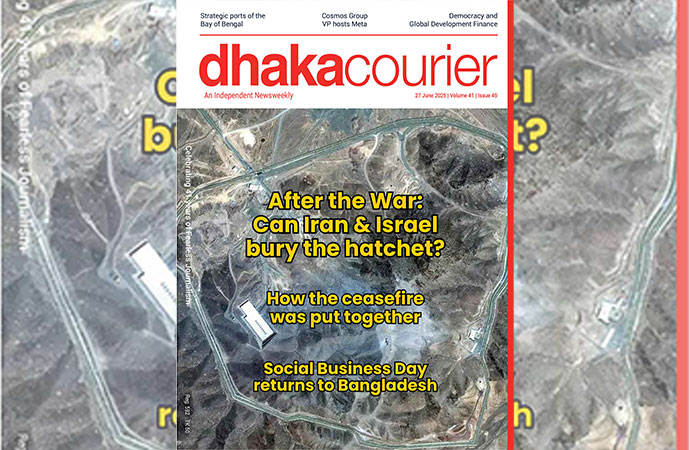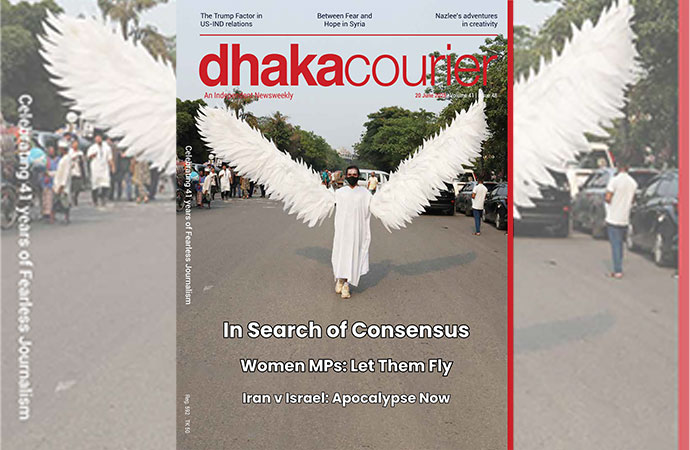Society

Sex Worker at a brothel in Bangladesh, Photo- Philip Gain
Prostitution' frequently said as the oldest profession in the world has been existed through history and there were kings who ensured security at Harem, poets, politicians who found words at women's cheek, religions treated prostitutes as Devis (goddess) and now in modern time, it has turned into a profession of distress and misery.
The modern so-called female broker, Shamima Nur Papiya, has come up with a strong stick with cruelty to treat sex workers as slave and provided livelihood of Tk 10,000 to Tk 30,000 for girls from Narsingdi for the sake of selling bodies.
The question is who are sex workers, cherished by history for centuries? Why did they take this profession? Who brought them to this dark world? Where are they from? Who do buy sex? Do they want to stay in this profession?
There are other questions too, are the sex workers subject to society or the society a subject to them? Is there any barrier for anyone in the society to be a customer?
The answers are not so easy but in this report we tried to provide information about selling sex for survival, which is often categorized as a 'disgraceful profession' in Bangladesh's society.
We tried to depict the true picture of selling sex and workers' detail information in the country's eleven brothels in nine districts.
With over two-decade experience, Society for Environment and Human Development (SEHD) has made many questions clear about sex workers in several research books.
SEHD published a book on sex workers in Bangladesh in Bengali titled 'Jiboner Dame Kena Jibika' in 2000 and later published its extended English version titled 'Sex Workers in Bangladesh, Livelihood: At What Cost' in 2004.
In continuation of that, SEHD published a research book in 2019 titled, 'Bangladesher Jounapalli O Jounakarmi' Halnagad Chitra 2018, (Brothels and Sex workers in Bangladesh, an update 2018).
SEHD conducted survey in 11 brothels under a project funded by European Union and Eco Cooperation where 31 organizations led by sex workers helped conducting the research.
The research team worked in between October 25, 2017 and March in 2018 in eleven brothels while they conducted survey outside the brothels from January 1, 2018 to March 16, 2018.
Philip Gain, director, SEHD worked as the team leader and chief researcher with his co-writers James Sujit Malo, Aleya Akhter Lily, Rabiullah and Borsha Chiran.
Number of brothel-based sex workers in Bangladesh
A total of 3,721 sex workers in eleven brothels on 30.07 acres of land in nine districts, came to this profession by force, choice, birth and brokers, says SEHD study.
The largest brothel by number is at Daulatdia in Rajbari shelters 1,420 sex workers while the second largest brothel is in Tangail where 611 prostitutes were identified by 2018.
Besides, 500 sex workers at Rathkhola brothel and 200 in C and B Ghat brothel in Faridpur Sadar upazila, 350 in Mymensingh brothel, 210 in Jamalpur brothel, 150 in Patuakhali brothel, 80 at Banishanta brothel in Khulna's Dacope upazila, 60 in Bagerhat brothel, 100 in Marua Mandir Brothel, and 40 sex workers were enlisted at Babubazar brothel in Jashore district till the end of 2018.
The eleven brothels also shelter 1,114 children (age below 18), 2,628 Babus or Veruas (regular customers and deeply related to sex workers), 193 brokers, 275 leaders (Sardarnis) and 447 of other professions, the Study shows.
The brothels in Tangail and Mymensingh were established in 1818 and 1897 respectively while two brothels in Jashore were first introduced in between 1930 and 1935. Banishanta in Khulna, and two brothels in Faridpur were established in between 1974 and 1987, says the study.
In the meantime, Tangail brothel was evicted in 2014 and was reestablished, which is a rare case, says the study.
The largest brothel that sheltered over 5,000 sex workers was at Tanbazar in Narayanganj was evicted in 1999. Another brothel at Neemtali in Narayanganj, and one each in Madaripur and Magura were also evicted later.
After that incident, the sex workers went to the court, and in 2000, the High Court ruled that 'prostitution' as a livelihood is not illegal.
The HC also ruled that the 'prostitutes' in Bangladesh now have the legal rights to practice their trade. And evicting someone from ones workplace is illegal. The court also took the view that, even if sex work is not illegal it is not encouraged.
Besides the 3,721 sex workers in eleven brothels, more than 90,000 prostitutes have been working in hotels, flats, and as floating workers in the country, says SEHD study.
The study as its limitation said researchers could not reach thousands of floating sex workers, transgender and male sex workers.
How do they get into the profession?
The study shows that pimps brought about 73.33 percent sex workers into brothels taking advantage of poverty, family feuds, suppression by husbands, and livelihood crisis.
Almost 24.44 percent sex workers took the profession willingly and most of them are widowed, while only 2.22 percent sex workers born into brothels get into the profession by birth, the report says.
According to Section-11 under Chapter 2 of the Prevention and Suppression of Human Trafficking Act 2012, "If any person brings any other person into Bangladesh or transfers the person inside the territory of Bangladesh with a view to engaging in prostitution or any other form of sexual exploitation or oppression by means of force of fraud or seduction, shall be deemed to have committed an offence and shall for the offence be punished with rigorous imprisonment for a term not exceeding 7 (seven) years but not less than 5 (five) years and with fine not less than taka 50 (fifty) thousand."
Income of sex workers and their leaders (Sardarnis) in brothels
The SEHD study shows that each of the sex workers in eleven brothels earns about Tk 30,000 monthly on average but the rates are different in each of eleven brothels.
A prostitute at Mymensingh brothel earns Tk 50,000 on average, which is the high income zone in the country for sex workers.
Meanwhile, a leader of sex workers known as 'Sardarni' earns about triple times of a sex worker's income.
Each Sardarni in Mymensingh brothel earns Tk 110,000 monthly on average while about 275 Sardarnis in nine brothels earn about 67,250 monthly on average, says the study adding that there's no Sardarni in Tangail brothel.
The total yearly income generated by sex workers at eleven brothels is Tk 133.85crore while Sardarnis at ten brothels earn Tk 27.69crore.
Drugs business at brothels
Drugs mostly liquor and hemp is being sold at about 124 shops in eleven brothels. Among that four hemp shops were established only in Banishanta brothel near Mongla Sea Port in Khulna.
Meanwhile, 72 shops of local liquor shops of 124 are situated in Mymensingh brothel where sex workers wait with liquor for customers as that's the second mean of brothel entertainment after sex.
Beside selling sex, small number sex workers among 3,721 are involved in drugs business and earn about Tk 9.87 crore yearly, the study shows.
Sex workers' daily expenditure
The monthly expenditure of each sex worker is Tk 21,783 on average and the sectors include food, utilities, house rent, clothes, cosmetics, ornaments, entertainment and others.
Every sex worker pays Tk 8,363 which is 38.39 percent of one's total monthly expenditure, SHED shows in its study.
Sex workers' education
Altogether 2,069 sex workers among 3,721 which is 55.60 percent can write their names only while 304 (8.17 percent) are totally illiterate.
Scrutinizing in all eleven brothels of the country, 946 (25.42 percent) sex workers were found class five passed, 376 (10.10 percent) found eight passed and 24 (0.64 percent) were found SSC passed and only two girls were found HSC passed among 3,721 sex workers.
Health and sanitation facilities in brothels
Poor sanitation facilities is one of the health issues at brothels where 5.94 percent sex workers use hanging toilets, 18.22 percent use toilets put on ring slabs while 75.84 percent use concreted (Paka) toilets.
Generally sex workers suffer from various sexual diseases like syphilis, gonorrhea, chlamydia, fungus infections, uterus cancer, white discharge, hemorrhage, HIV Aids etc.
According to sex workers' statements during the survey, 93.33 percent said their customers use condoms but 6.67 percent said their customers do not use it that pose health risks.
Almost 57.04 percent sex workers said they did abortions and some of them did it several times, the report said.
The profession is all about alluring customers and entertainment by flesh, but to gain that fleshy beauty, sex workers take 'Oradexon' and steroid tablets to be attractive despite health risks. Oradexon tablets are used for cattle fattening.
According to a survey by Action Aid Bangladesh in 2010, about 90 percent of sex workers in the country use these tablets.
Who are the customers?
People from different classes and professions come to buy sex at brothels. Small businessmen, politicians, job holders, labourers and people of other professions are main customers there.
A book (Jiboner Dame Kena Jibika), written by Qurratul Ain Tahmina and Shishir Moral, published by SEHD, reveals that 33 percent of the customers is businesses, 16 percent is students, five percent is of different professions (lawyers, teachers and journalists), six percent from different law enforcing agencies and 40 percent customers are shown of other category.
Social safety net activities and sex workers
There is no specific social safety scheme for sex workers at eleven brothels but they are allowed to receive facilities from existing government schemes.
Altogether 243 sex workers receive services from Vulnerable Group Feeding (VGF) Programme, Vulnerable Group Development (VGD) programme, Lactating Mothers' Allowance and Open Market Sales (OMS) facilities.
Besides, three sex workers get Disability Allowances (DA), one gets widow allowance while ten children of sex workers receive primary scholarships, the study shows.
Suppression beyond the enduring capability
Suppressed by own families, when sex workers enter into brothels, they start experiencing another episode of torture, injustice by Sardarnis, customers and their Babus (Veruas).
Deception, torture and inhumane life of indignity are the daily mates of sex workers at brothels. Despite having desire to change the professions, they have literally no way.
82.96 percent sex workers want to change the profession
When asked if they want to change the profession, 82.96 percent of sex workers said yes and 17.04 percent said no, says the SEHD report.
Even though they want to change the profession, it's harder because the society would not accept them very easy.
Moreover, most of the sex workers have very few skills and get habituated with the life of brothels and feel free to spend life there till death.
The report also says that about 65.19 percent have communications with their families (parents and husbands).
The report depicts the situation of only 3,721 sex workers of eleven brothels but there are thousands of untold stories of more than 90,000 sex workers who have been working in hotels, flats, and as floating workers in the country.

























Leave a Comment
Recent Posts
Wrestling legend Hulk Hogan di ...
Hulk Hogan, the iconic mustachioed showman who helped transform profes ...
‘Punoray: shaping the future, ...
In a compelling initiative that seeks to bridge art, craft, and the st ...
Rangamati mourns death of Ukya Ching Marma in Milest ..
Uttara plane crash: A guardian’s last act of love
BIMSTEC for addressing security challenges that hind ..
The longest week yet, in Bangladesh 2.0